Difference between revisions of "User:Heritagefutures/WorkSpace2"
(→Lenses) |
(→Front Standard) |
||
| Line 76: | Line 76: | ||
===Front Standard=== | ===Front Standard=== | ||
| + | The front standard of a field camera requires two key movements to allow the camera being folded and two movements to allow for vertical adjustment. To allow the full collapse of a field camera into its transport position, the front standard needs to be folded back, but the lens board needs to be swivelled forward. To allow for vertical adjustment of the optical axis, the camera needs to allow the lens board be moved upwards (shift) and swivelled back or forward (tilt). To allow for reliable outcomes, the photographer requires the ability to lock the front standard in place in it's desired position. Moreover, the lens cannot remain in place when the camera is collapsed. It can either be unscrewed from its flange on the lens board, or the entire lens board can be removed A number of engineering solutions exist for all these requirements, which provide for distinguishing features. | ||
<center> | <center> | ||
{| border="1" cellpadding="4" style="margin: 0.5em 2em; text-align: left; vertical-align: top; border-collapse: collapse;" | {| border="1" cellpadding="4" style="margin: 0.5em 2em; text-align: left; vertical-align: top; border-collapse: collapse;" | ||
| Line 108: | Line 109: | ||
}}|} | }}|} | ||
</center> | </center> | ||
| − | |||
===Hinge of Rear Standard=== | ===Hinge of Rear Standard=== | ||
Revision as of 02:20, 14 August 2012
Contents
Japanese Field Cameras
Japanese kabine-format field cameras were the mainstay of photographers at the nation's Shinto shrines providing portraits of visitors attending ceremonial events ¶¶¶. In addition, smaller tefuda-sized units were also manufactured
Overview
The collapsible single- and double extension cameras, based on British designs, were produced by a range of manufacturers, chiefly Asanuma Shōten (浅沼商店), but also Konishi Honten (小西本店), Funahashi, Oriental Shashin (オリエンタル写真) and others.
Table 1 Japanese Field Cameras
| kabine (カビネ) |
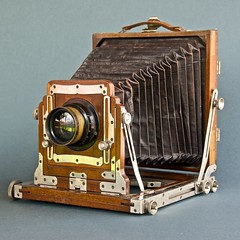
|

|

|

|

| |
| Konishi Honten, Osaka & Tokyo | KABINE B CAMERA | KABINE C CAMERA | KABINE D CAMERA | KABINE E CAMERA | ||
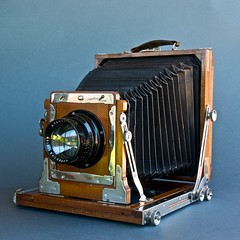
|

|

|

|

| ||
| Asanuma Shōkai King Kansha-Gō | KABINE G CAMERA | KABINE H CAMERA | KABINE I CAMERA | KABINE K CAMERA | ||
| tefuda (手札) |
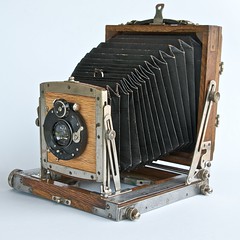
|

|

|

|

| |
| M. Funahashi & Co, Osaka | TEFUDA B CAMERA | TEFUDA C CAMERA | TEFUDA D CAMERA | TEFUDA E CAMERA | ||
| images by Dirk HR Spennemann (Image rights) | ||||||
Lenses
The design of the cameras remained stable from the turn of the nineteenth century until World War II. Initially a range of lenses was utilised, subject to the penchant of the individual photographer, coupled with the range of offerings by the camera maker or distributor. Documented are, inter alia, ¶¶¶
In the 1930s, the primary lenses for the kabine-format cameras were 21cm barrel lenses fitted with a slip on Thornton-Pickard-type rouleau shutter usally mounted in front of the lens. In addition to imported German, esp. Zeiss, as well as French lenses (e.g. TCW "Modelar distributed by Tokyo Camera Works), a number of Japanese lens manufacturers carried 21cm offerings to service the demand:
- Rokuoh-Sha Hexar 21cm f/4.5
- Minolta Rokkor 21cm f/4.5
- Tōkyō Kōgaku Simlar 21cm f/4.5
- T.Y.O.W. Taiyo Anastigmat 21cm f/4.5 and f/6.3
- WIPA Yamat-Anastigmat 21cm f/4.5
- Yamasaki Congo Anastigmat 21cm f/4.5
Of these, the Congo and Hexar lenses are the most common.
Tripods
The cameras have a tripod base that allows slipping in three individual legs
add images, but reshoot them first
Distinguishing Characteristics
Front Standard
The front standard of a field camera requires two key movements to allow the camera being folded and two movements to allow for vertical adjustment. To allow the full collapse of a field camera into its transport position, the front standard needs to be folded back, but the lens board needs to be swivelled forward. To allow for vertical adjustment of the optical axis, the camera needs to allow the lens board be moved upwards (shift) and swivelled back or forward (tilt). To allow for reliable outcomes, the photographer requires the ability to lock the front standard in place in it's desired position. Moreover, the lens cannot remain in place when the camera is collapsed. It can either be unscrewed from its flange on the lens board, or the entire lens board can be removed A number of engineering solutions exist for all these requirements, which provide for distinguishing features.
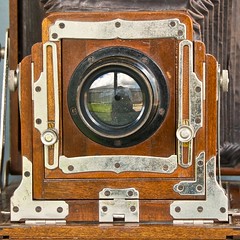
|

|

|

|

|
| Konishi Honten, Osaka & Tokyo | KABINE B CAMERA | KABINE C CAMERA | KABINE D CAMERA | KABINE E CAMERA |

|

|

|

|

|
| Asanuma Shōkai King Kansha-Gō | KABINE G CAMERA | KABINE H CAMERA | KABINE I CAMERA | KABINE K CAMERA |
| images by Dirk HR Spennemann (Image rights) | ||||
Hinge of Rear Standard
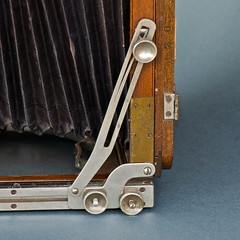
|

|

|

|

|
| Konishi Honten, Osaka & Tokyo | KABINE B CAMERA | KABINE C CAMERA | KABINE D CAMERA | KABINE E CAMERA |
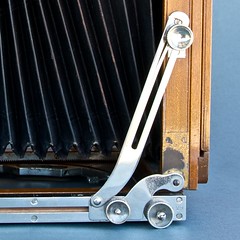
|

|

|

|

|
| Asanuma Shōkai King Kansha-Gō | KABINE G CAMERA | KABINE H CAMERA | KABINE I CAMERA | KABINE K CAMERA |
| images by Dirk HR Spennemann (Image rights) | ||||
Focussing Screen
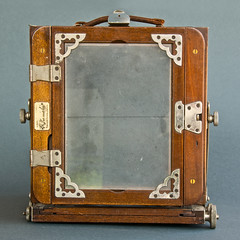
|

|

|

|

|
| Konishi Honten, Osaka & Tokyo | KABINE B CAMERA | KABINE C CAMERA | KABINE D CAMERA | KABINE E CAMERA |

|

|

|

|

|
| Asanuma Shōkai King Kansha-Gō | KABINE G CAMERA | KABINE H CAMERA | KABINE I CAMERA | KABINE K CAMERA |
| images by Dirk HR Spennemann (Image rights) | ||||
Focussing Screen Fasteners
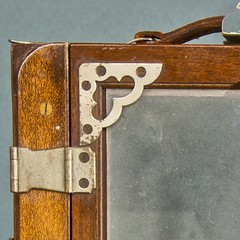
|

|

|

|

|
| Konishi Honten, Osaka & Tokyo | KABINE B CAMERA | KABINE C CAMERA | KABINE D CAMERA | KABINE E CAMERA |
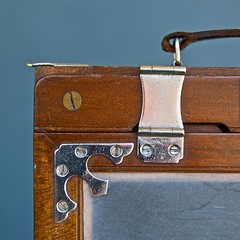
|

|

|

|

|
| Asanuma Shōkai King Kansha-Gō | KABINE G CAMERA | KABINE H CAMERA | KABINE I CAMERA | KABINE K CAMERA |
| images by Dirk HR Spennemann (Image rights) | ||||
Tripod plate
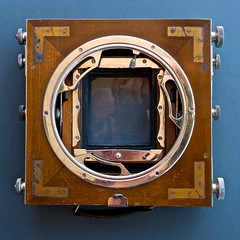
|

|

|

|

|
| Konishi Honten, Osaka & Tokyo | KABINE B CAMERA | KABINE C CAMERA | KABINE D CAMERA | KABINE E CAMERA |

|

|

|

|

|
| Asanuma Shōkai King Kansha-Gō | KABINE G CAMERA | KABINE H CAMERA | KABINE I CAMERA | KABINE K CAMERA |
| images by Dirk HR Spennemann (Image rights) | ||||
¶ ¶ ¶ CRITERION

|

|

|

|

|
| Konishi Honten, Osaka & Tokyo | KABINE B CAMERA | KABINE C CAMERA | KABINE D CAMERA | KABINE E CAMERA |

|

|

|

|

|
| Asanuma Shōkai King Kansha-Gō | KABINE G CAMERA | KABINE H CAMERA | KABINE I CAMERA | KABINE K CAMERA |
| images by Dirk HR Spennemann (Image rights) | ||||